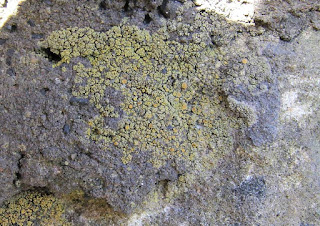With high hopes I headed for Dysart with broadly three areas in mind to list - (1) the littoral zone including the harbour and coastal rocks; (2) the trees at the east end of Ravenscraig park above the harbour and (3) the town. In the end I was underwhelmed at the amount of lichens on show, but overwhelmed with the percentage of crustose saxicolous species I couldn't name. There was little representation of those species already in the BLS database for the square, particularly epiphytes and littoral species. A more experienced lichen-botherer could have undoubtedly done better, but there were a lot of areas where there were no lichens, and a lot of new/newish stone. The trees, mature sycamores mostly, were all but bare and the littoral zone was bewilderingly lacking in lichens.
Since I timed the visit for low tide I started inside the harbour walls, where I fuond Verrucaria mucosa and a Caloplaca I haven't named yet. I had a chat about lichens with one of the locals who had spread the word about lichens to one of his friends by the time I was leaving the harbour!
 |
| Verrucaria mucosa |
 |
| Caloplaca and friend |
Also inside the harbour were a 'Candelariella' or two (edit: well ... not quite. K+ says otherwise! C.verruculifera with hindsight), also still to be named, though one looks like maybe C.vitellina. There were other crustose "grey" species also.
Emerging from the harbor to greet the new budding lichenologists of Dysart a low wall contained a few species, amongst which was this Verrucaria nigrescens and what seems to be Rhizocarpon reductum (I couldn't get any spores out of it)
 |
| Verrucaria nigrescens |
 |
| Possibly Rhizocarpon reductum |
One Verrucaria which covered quite a big area was Verrucaria ditmarsica. It was only present in areas where the stone was slightly more sheltered, but in those areas it covered the surface.
Abandoning the shore, after picking up a promising stone for later examination I found a few smooth bark species but nothing else on sycamores and an ash. At least some of these - Opegrapha atra and Arthonia radiata, were new to the square, and Lecanora chlarotera and Lecidella elaeochroma were also there.
Making my way to the wall above the harbour I found a species or two more before making my way back down to the town
 |
| Caloplaca ... keys out to saxicola but I'm unsure |
 |
| Collema crispum |
























